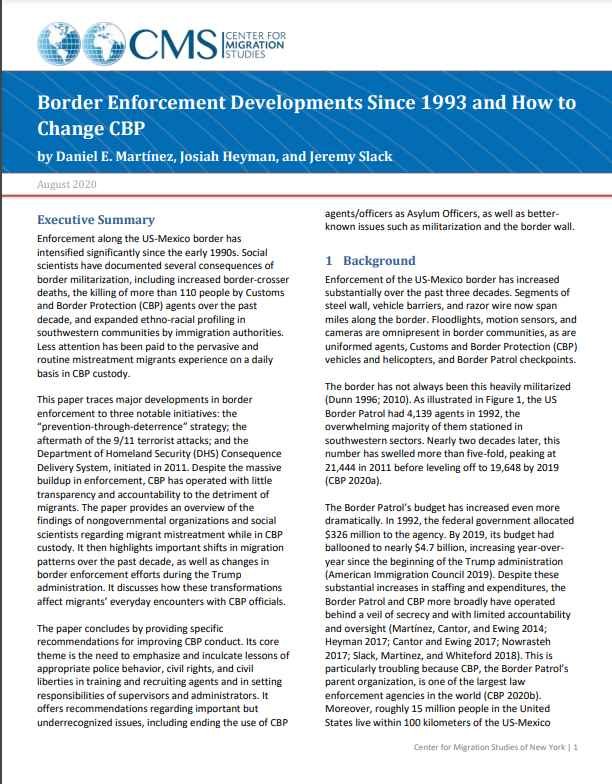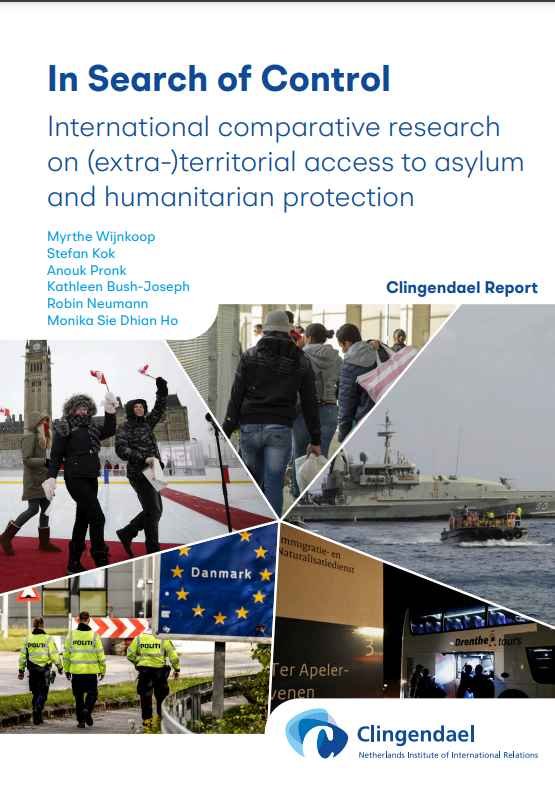By Daniela Alulema and Jacquelyn Pavilon
New York City is a “welcoming city” that encourages “all New Yorkers regardless of immigration status” to access the public benefits and services for which they qualify (NYC Mayor’s Office of Immigrant Affairs or “MOIA” 2021a). Moreover, it invests significant resources in educating immigrant communities on this core commitment and its lack of participation in federal immigration enforcement activities. However, this report by the Center for Migration Studies of New York (CMS) finds that immigrants in New York City still face significant barriers to accessing public benefits and services.
The report is based on CMS research that examined immigrant fear and other barriers in three general areas: the use of public benefits, with a particular focus on the public charge rule; the use of public health services; and access to law enforcement and the courts. The report documents how Trump-era immigration policies perpetuated fear among immigrant communities, in the context of other barriers to accessing services and benefits, and why its detrimental impacts have persisted and outlived the Trump administration.
The research included semi-structured interviews with 75 immigrants across all five boroughs of New York City and two focus groups with immigrants in both English and Spanish. The interviews documented the prevalence and impact of fear and other factors that impede (and facilitate) immigrants’ use of public benefits and services. The respondents were from 30 countries across all regions of the world and had varied legal statuses and lengths of stay in the United States. The CMS research team also interviewed 16 social service providers from community-based organizations (CBOs) and New York City agencies, including the Department of Health and Mental Hygiene (NYC DOHMH) and the Human Resources Administration/Department of Social Services (HRA), and eight healthcare providers and social workers from the city’s public hospital system, NYC Health + Hospitals, who worked with immigrants across the city.
The project ran from January 2020 through October 2021, spanning most of the last year of the Trump administration and most of the first year of the Biden administration. Data collection started in November 2020 and extended through the COVID-19 vaccine rollout starting in spring 2021. The report finds that Trump-era anti-immigrant rhetoric and immigration policies, including aggressive enforcement tactics and a new rule on the public charge ground of inadmissibility, exacerbated long-standing fear pertaining to lack of status, family separation, detention, and deportation. The COVID-19 pandemic has further increased the need for services and assistance for all New Yorkers, including immigrants.
The report also finds that the change in administration, the widespread recognition of the essential work of immigrants in response to COVID-19, and the pandemic’s disproportionate impact on immigrant and minority communities did not eliminate immigrants’ fear or other barriers to accessing public benefits and protection in one of the most immigrant-welcoming communities in the country. Misinformation, language barriers, culturally-rooted concerns, and discrimination continued to impede immigrants from coming forward for needed services and benefits for which they or their family members are qualified. As one immigrant explained: Yes, I’m aware the public charge act has been rescinded by the Biden administration, but people still think it is not safe. People will tell you, ‘Yes, but you never know when [the rule could] come back.’ They say they don’t want to jeopardize their chances of bringing their children, so they want to focus on the bigger picture as opposed to some money.
The report finds that while government agencies, hospitals, and CBOs have all taken steps to minimize gaps in service provision and to mitigate immigrants’ fear, more can and should be done. It offers the following top-line findings, supplemented by additional findings in the body of the report:
The Public Charge Rule and Immigrants’ Concerns on the Use of Public Benefits
Many respondents underutilized benefits for which they were eligible due to fears pertaining to immigration status, family separation, detention, and deportation. For example, a service provider recounted a case in which a mother feared that her US citizen children would be negatively impacted in the future for having used food stamps: She’s an immigrant. It’s her husband and her, and [her] two American citizen [children]. The husband died due to COVID. When she applied [for food stamps,] she really didn’t want to apply. She was under the impression that also her kids are going to be penalized and they’re going to have to pay this back when they grow up. Because she doesn’t have any status, she was afraid. If she want[ed] to apply, she could, for the kids. … I had mentioned to her [what] the requirements [were], which [were] proof of income and address, and she said that she will get a letter from the employer, because that’s part of the requirements. When she asked for the letter, she got fired. She was just so devastated, because she was at her wit’s end. I called her, and she said, no, she didn’t want to be bothered. She was just so frustrated and devastated, and she just let it go.
Trump administration policies and rhetoric led immigrants to increase their efforts to secure a safer immigration status, including citizenship, and obtain identification documents for themselves and their children. The study found that service providers had to step out of their regular roles to provide the services that the immigrant community needed. In the midst of an unprecedented public health crisis, for example, hospital workers were also helping to fill out patients’ citizenship applications.
Context and location strongly influenced the comfort level of immigrants in sharing information which would allow them to access benefits and services. Many immigrants feared sharing identifying information in government buildings, but not as much in other settings or online.
Large numbers of respondents feared the use of public benefits, including by their US citizen children, due to misinformation about the impact of the new public charge rule on their ability and the ability of family members to secure legal status or permanent residence. Social media has made it easier to spread incomplete information or misinformation about the presence of Immigration and Customs Enforcement (ICE) in local neighborhoods, as well as about the details of the public charge rule........
New York: Center for Migration Studies, 2022. 69p.


























